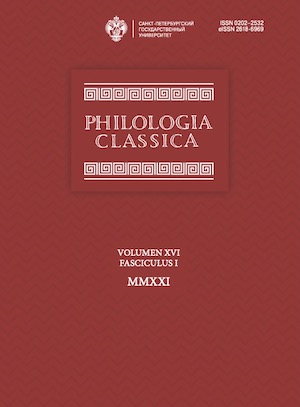A Reading of Fragments 926(a) and 926(g) PMG within the Context of the New Music
DOI:
https://doi.org/10.21638/spbu20.2021.102Abstract
There has been much controversy regarding the date, the performative context, and the generic quality of fragment 926 PMG, which has been preserved on papyrus (P. Oxy. 9 + P. Oxy 2687) in a rhythmical treatise by an unknown author. The verse fragments on this papyrus were composed in iambic dactyls (∪ — ∪ –) and used as examples of the occurrence of syncope in various lyric meters. Fragments 926(a) and (g) PMG are from a composition performed by a maiden chorus which bear similarities to Alcman’s partheneia and have affinities with archaic epic and lyric poetry. Supposedly, these fragments might have been fragments of partheneia composed in the time of the New Music. Nonetheless, they are not shaped according to the bulk of the aesthetic values and the compositional rules of the New Music. These fragments seem to belong to cultic songs created for maiden choruses, possibly, to honor Dionysus. The alternative is that they imitate such songs within a dramatic context. We may assume that these quasi-dithyrambic partheneia were composed to serve religious needs or at least imitated cultic songs. They looked backward to the archaic and early classical tradition of partheneia, and their existence is an indication that, in the days of the New Music, there was a poetic tradition upheld by “reactionary” poets.
Keywords:
New Music, partheneia, late classical lyric
Downloads
References
Downloads
Published
How to Cite
Issue
Section
License
Articles of "Philologia Classica" are open access distributed under the terms of the License Agreement with Saint Petersburg State University, which permits to the authors unrestricted distribution and self-archiving free of charge.






